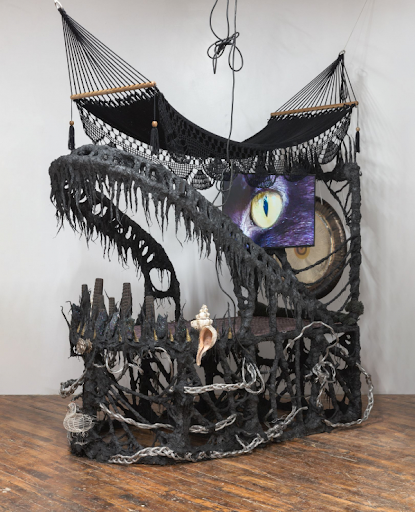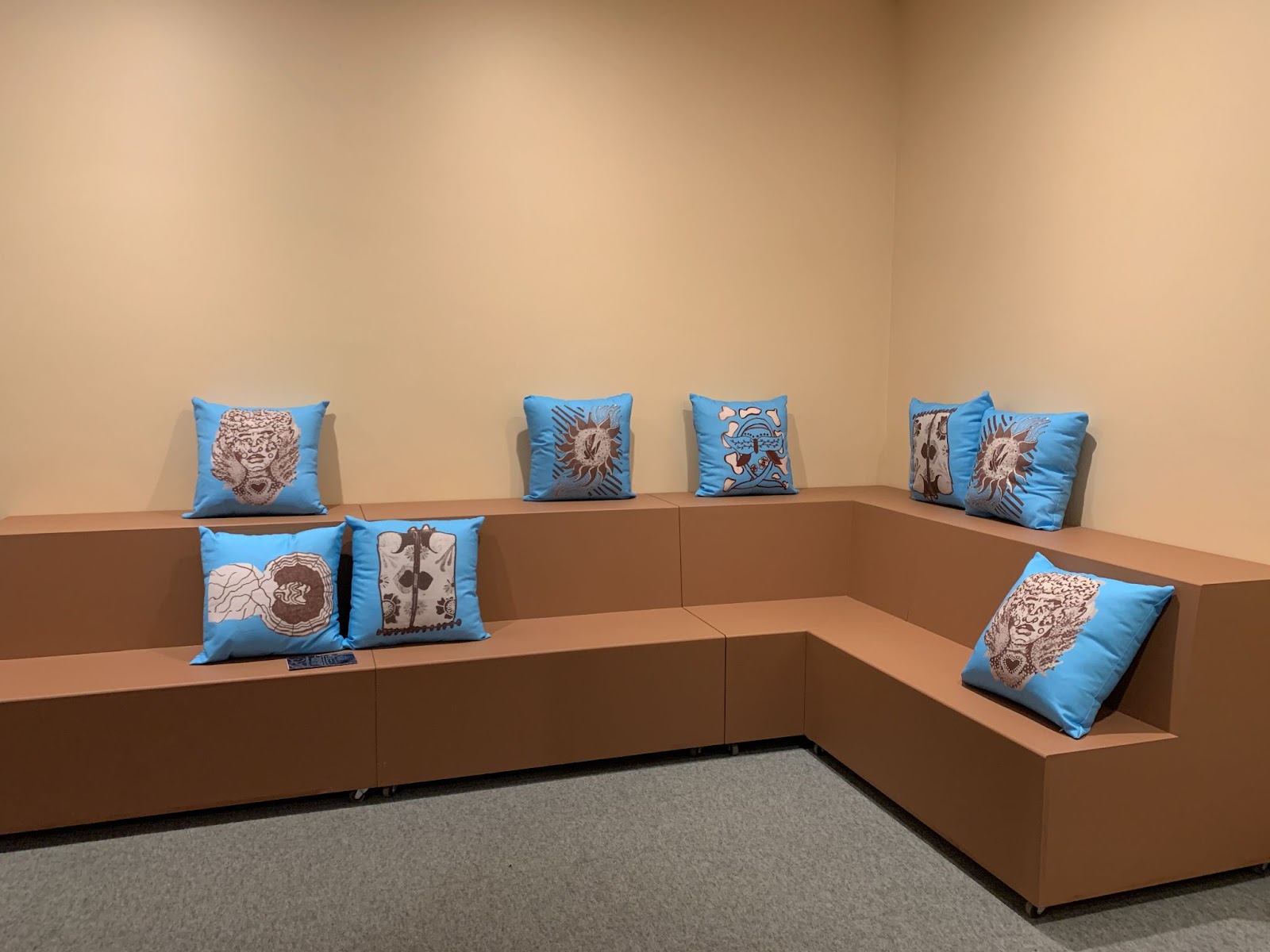Conceptualizing a Healing Room: A Conversation between CUNY’s Mindscapes Team and the Brooklyn Museum’s Work-Study Staff
June 27, 2022

How can art help us heal from trauma? Artist Guadalupe Maravilla explores the relationship between art and healing in his exhibition, Tierra Blanca Joven,on display at the Brooklyn Museum from April 8 to September 18, 2022. The show explores themes of migration, illness, and healing, drawing from Maravilla’s own experience of displacement during El Salvador’s civil war and his recovery from cancer in the 2010s. The exhibition includes sculptures, sound works, and a Healing Room. This exhibit is part of Mindscapes, Wellcome’s international cultural program about mental health.
The Healing Room was created by the museum’s work-study staff under the supervision of Lindsay C. Harris, Interim Director of Education and Teen Programs Manager at the Brooklyn Museum. The work-study program is a paid internship offered by the museum, which aims to teach teens over 14 years old about art, education, and mental health. This year the program was developed and facilitated by Harris, Art & Healing Teaching Artist Zena Zendejas, and Associate Manager of Art-Making Initiatives Noé Gaytán. The Center for the Humanities is a local partner on Mindscapes, and the Mindscapes cohort of graduate student researchers assisted in the research process to create the Healing Room.
Having worked to support the development of resources for this space, we wanted to learn more, so we asked Harris and five of the work-study staff who were involved in the creation and maintenance of the exhibition’s Healing Room about their experience with the program and their thoughts on art and healing. We thank Anne Brutus, Maya Anaman, Nicole Sanchez Flores, Sidhratul Murad and Zoe Pyne for their insights on this collaborative journey toward visualizing healing in a museum space.
Helena and Dunni:How did the idea of the Healing Room come about?
Sid: The idea of the Healing Room came about after our team responded to weekly prompts provided by one of the teaching artists, Zena. We steadily developed an idea of what our ideal “Healing Room” would be—the healing room being a place where we feel at ease and feel comfortable growing, self-reflecting, and healthily overcoming trauma. By combining little tidbits from all our healing rooms, we were finally able to create the Healing Room.
Maya: I remember when Lindsay asked us “What does healing mean?,” and I realized we all had different ways of defining it. It can mean so many things to so many people.
Nicole: We had a lot of meditative experiences, and so we got the idea of engaging the five senses. Touch, sight, sound—these are all things that relaxed us. One of the most important things about having a healing room is just being comfortable.
Anne: The prompts were open ended and encouraged us to reflect. Zena also gave wonderful guided meditations! A lot of what went into creating the healing room was allowing ourselves to have new experiences, to try new techniques in our own lives.

Helena and Dunni: What is your favorite item featured in it?
Zoe: I really love the pillows since it feels like such a comfortable and homey feature.
Anne: My favorite feature would have to be the community notebook. When looking through, I often smile at the pieces of advice and experiences. It is beautiful to witness others freely express themselves.
Sid: I have to be honest—my favorite items have to be the bean bags! They were such a great addition to the Healing Room; including them was a great way to incorporate our tripa chuca games while adding an element of rest and relaxation to the room. Sinking into them after a long, stressful week can do wonders to my stress levels.
Nicole: My favorite item is the zine that guests are allowed to take home. I felt more personally connected to the zines because they were made from our own journals while working on the exhibition. At first, I didn’t think of myself as a strong writer or an artist. I’ve only really doodled in my journal. It’s nice to see how my doodles and random thoughts could be alongside something more meaningful to me.
Helena and Dunni: What do you want people to walk away with when they interact with the Healing Room?
Zoe: I’d love for people to think of the multifaceted nature of healing and have a broadened perspective on it from when they first entered.
Anne: I agree with Zoe! I hope visitors can gain new tools for healing and expression. I also hope that visitors feel they are a part of a community—there are spaces that will welcome them and encourage their growth.
Sid: I think that whether or not visitors want to walk away with something is something entirely up to them—but I’d like for the Healing Room to leave some sort of a positive impact. I’d like for those who don’t initially see the link between art and healing to feel as though they learned something about the nature of healing and how art may play a role in that.
Nicole: I wanted people to feel a sense of inclusion. The things I noticed ranged from the larger theme of immigration, belonging and being lost, to subtle things like Spanish translations on the wall. I felt like it connected to me on a very personal level.
Once I entered the exhibition, I felt my tears escape from me. The map of Guadalupe Maravilla’s journey to the US made me have this reaction. It reminded me a lot of my parents’ immigration to the US, and how it may have affected me as a person with undocumented parents. Seeing it just felt too real, and I can only imagine what my parents went through to get here.
I don’t think I’ve connected to an exhibition in any other museum like I have with Maravilla’s. I felt heard, noticed. I feel like many Latino Americans, or immigrants, or children of immigrants would get the message, would feel something. Not many have really included us; maybe sometimes I felt forgotten. The Spanish translations of Maravilla’s work were so important to me. It meant that my family could understand his work, my work, and not through my limited, sometimes broken Spanish. The Healing Room was necessary. It helped me process these emotions, tear up a bit, and just relax.

Helena and Dunni: What was the most interesting thing that you learned in this process?
Maya: I learned about my own healing journey and more about how I have healed, and continue to heal. The space helped me put healing and grief into my own words. Grief had always been a touchy subject for me, so sitting down and exploring it in different forms was an amazing experience.
Zoe: Personally, there was a lot that I was unaware about concerning the logistics of creating an interactive exhibition within a museum setting.
Anne: The floor plan of the Healing Room and how to make it accessible to different audiences was important. The curtains created a transformable space—allowing the room to be intimate and accessible by wheelchair.
Nicole: The most interesting things are the masks and the sounds that resonate throughout the Healing Room. It makes you feel relaxed enough for you to process what you went through, whether it’s just your daily occurrences or something much deeper. It feels like all other thoughts are forgotten for a moment.
Sid: There are so many factors that you need to take into account when planning exhibits. I knew it was an extensive process but I didn’t realize just how many elements you had to consider. For example, one of our peers mentioned adding a scent to the Healing Room to add another sensory appeal. However, we couldn’t carry that out because it wasn’t something that would please everyone.
Helena and Dunni: Would you incorporate a Healing Room into future shows or other work ventures?
Zoe: Yes! I think that it’s a great addition to the show and makes it feel more accessible to different groups. For example, I planned a trip to the museum with my school and the space was incredibly useful for relaxing while still engaging with the exhibition. It also piqued the interest of many students who then asked me how to get involved with the museum.
Anne: Definitely! An interactive space like the Healing Room provides access to resources. These spaces encourage visitors to explore and have discussions. This in turn can encourage the social-emotional development of our communities.
Sid: I totally agree with Anne and Zoe. I think it’s great to have a place where you can sit and think about the art you just saw—or anything else from the day!
Nicole: Yes, I would. I don’t think we’re done healing, especially with the pandemic still following us. As a teenager, you really don’t “get” yourself, and sometimes you feel a little lost. Projects that can include some sort of healing element like this exhibition can allow teens to explore themselves more, work through the hardships that they’ve never acknowledged before, that they’ve cast aside.
Anyone interested in art and healing can visit Maravilla’s exhibition and interact with the Healing Room at the Brooklyn Museum until September 18, 2022.